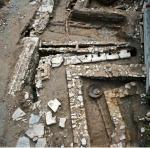Summary (English)
AUGUSTA TRAIANA – VEREYA (Dimitar Yankov – dimiter_yankov@yahoo.com) The pavement of stone slabs of the decumanus maximus was revealed. A drain paved with bricks was discovered to the south of the decumanus maximus. It was connected to a building and served for collecting the rain water from the southern ridge of the roof which reached the colonnade. The positions of the bases were documented on the stylobate. The distance between the centers of the bases was 3.70 m. Two buildings were discovered to the west of Room No. 8 of the building consisting of parallel rooms arranged in a line. Building No. 1 was constructed of roughly-cut stones bonded with mortar. Its eastern wall was perpendicular to the kerb of the decumanus maximus. A row of public latrines that existed until the end of the 3rd – beginning of the 4th century AD was discovered at 2.50 m to the east of Building No. 1. Building No. 2 was constructed of roughly-cut stones bonded with mortar. Its northern wall was constructed in line with the kerb of the decumanus maximus. A cardo was situated between the eastern wall of Building No. 2 and the western wall of Room No. 8. There was a drain built of roughly-cut stones and bricks and paved with bricks, running in the middle of the cardo. During the construction of Building No. 2 the row of latrines was dismantled and a single latrine was constructed on one of them. Other single latrines connected to the southern drain of the decumanus maximus were discovered during previous excavations. A system of water-conduits and two shafts for water recovery were discovered in the sector as well. Parts of cardo No. 1 located to the east of the Western Gate were explored. The monumental pillar, 1 m by 0.94 m in size, was revealed to the north of the decumanus maximus. Buildings were not erected in this part of Augusta Traiana until the 4th century AD when a building consisting of parallel rooms arranged in a line was constructed in rubble masonry. The building was burned during the first half of the 6th century AD. During the 11th century, buildings were erected on the site again. Christian Burial No. 2 was explored. The finds from the excavations included over 260 coins, a large number of them dated to the end of the 4th – 5th centuries AD.
- Dimitar Yankov - Regional Museum of History – Stara Zagora
Director
Team
Research Body
- Regional Museum of History – Stara Zagora






![Download [PDF]](/excavation/skins/fasti/images/results/download_sml.png)
